Let’s talk: information interoperability for the smart electrical grid
Alexandra George
Mar 21, 2019
As the electric grid reaches its capacity, the smart grid will power us into the future—offering a way for utilities and consumers to communicate with each other. Automated technology will enable greater efficiency and cost-effectiveness, where supply can meet demand and vice versa. Steve Ray, a distinguished research fellow at Carnegie Mellon University Silicon Valley, works at the intersection of smart machines and interoperability—or machine to machine interaction and understanding. Currently, he is looking at how communication between consumers and utilities can improve efficiency and lower the cost of energy transmitted through the smart electrical grid.
Ray is a collaborator on a three-year project funded by the California Energy Commission that is testing how dynamic pricing of electricity could affect consumer behavior for more efficiently managing supply and demand of energy resources. Working with researchers from Siemens Corporation and UC Berkeley, the team has demonstrated a way to reduce costs for consumers while simultaneously stabilizing the grid, making sure the demand doesn’t exceed the supply but is more equally balanced.

Source: Steve Ray
A diagram showing all of the standards that the team integrated to get the functionality they needed for the smart grid.
The long-term vision uses smart systems in large and small commercial buildings (similar to Nest thermostats) to enact real-time dynamic pricing of systems. Dynamic pricing means that utility companies can change the price of the grid in real-time. For example, if they see that consumption is going up, but they are running out of generating capacity, they could decide that in 15 minutes they will increase the price by 5% percent. The system would then send a signal to the consumers’ thermostats asking, if the price increases by 5% in 15 minutes what would your consumption be? In this dynamic way, it would help utilities control resources without directly controlling consumers’ electricity consumption.
But for the systems to communicate, they need a specific language or protocol. For the smart grid application, the Open Automated Demand Response (or OpenADR) standard is designed for this kind of dialogue between electrical grid systems.
Ray’s role with the project is based on his expertise in information interoperability and standards, ensuring that systems can communicate and share data in a completely understandable way across system boundaries. He works to identify the exact and literal meaning of information that is passed around electronically—for example time, units of measure, etc.
We’re trying to tease out all of the nuances of meaning
Steve Ray, Distinguished Research Fellow, CMU Silicon Valley
“We’re trying to tease out all of the nuances of meaning,” said Ray, “because they have a lot of bearing on all kinds of applications, including the one we’re working on now, which is the electrical grid.”
While structured models give insight into how data is ordered and sequenced, there still needs to be software to validate and interpret the data. To do this, experts look to the field of ontology and semantics to describe relationships between information in a way that computers can understand. The Carnegie Mellon team has built a semantic model using OWL—or Web Ontology Language, a logic language that allows you to describe information in a more expressive way than XML or HTML for example. They have converted the standards from multiple applications into OWL so that information can flow between applications using combinations of standards.
In this project in particular, they applied information interoperability methods to smart grid systems. They also developed a negotiation mediator to optimize energy use among collections of buildings, such as a campus. Together, these allow for easy communication regarding what the price of electricity is in 15-minute intervals, what tomorrow’s price is going to be, how the meter on a building communicates back to the utility how much electricity was used, and more.
The implications for this kind of system are huge. Currently, utilities cannot accurately predict the demand on any given day in real-time, they can only use information based on last year’s data and information like the weather. Automated demand response with dynamic pricing offers a way to optimize energy use and stabilize the grid without direct control over consumers’ utilities.
“It's all infrastructure,” said Ray. “It's all to do with just keeping the whole economy running flexibly, it runs on this kind of infrastructure.”